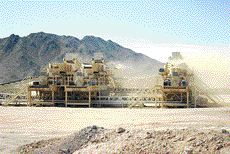New York City-based Capital Gold (CGC-T, CGLD-O) has given itself lots of breathing room to take advantage of rising gold prices by keeping both operating and capital costs low, a rare feat in today’s gold industry.
While the industry as a whole is producing gold at an average cash cost of US$371 per oz., or 21% higher than a year ago, according to London-based GFMS Limited, Capital Gold is expecting costs to average US$270 per oz. as it ramps up production at its open-pit Chanate gold mine, in northwestern Sonora.
Capital cost overruns of 20-30% are also becoming the industry norm. But Capital Gold was able to stay within its budget estimates for mine construction, completing the job for an estimated US$18 million and pouring its first gold in August, less than a year after raising the necessary financing from Standard Bank.
The key to containing capital costs was to leverage experience within the company to manage front-end roles that would normally be contracted out to an engineering firm at a premium. Chief operating officer John Brownlie was instrumental in this regard. He was the general manager (GM) for Newmont Mining’s (nmc-t, nem-n) Zarafshan-Newmont Joint Venture in Uzbekistan, a 1-million-tonne-per-month heap-leach plant, and previously served as chief engineer and GM for Monarch Resources (now part of Hecla Mining [hl-n]) in Venezuela.
“By doing our own design and procurement for the infrastructure, using one source for the leach pad and working directly with the crushing plant manufacturer, we were able to reduce the cost and improve the quality,” Brownlie says. “We also kept costs down during the construction phase by buying equipment like cranes and loaders fairly inexpensively in the U.S. and moving them to site.”
Cash costs are turning out to be relatively low partly because of an excellent waste-to-ore strip ratio of 0.6:1, compared to 2:1 or 3:1 in comparable pits, and partly because of high productivity among the workforce in a competitive labour environment.
“We re-engineered the organizational chart to allow more multi-tasking and started the operation with 80 employees compared to 120 in the original feasibility study estimates, so that got us into production with less (general and administrative) carrying costs,” Brownlie says.
El Chanate is small, but growing. The mine is currently operating near the feasibility study rate of 4,000 oz. per month, ramping up to 5,000 oz. per month, or 60,000 oz. per year. The combination of higher gold prices and recent drilling has increased the proven and probable gold reserves by 70% to 39.5 million tonnes grading 0.66 gram per tonne, or 832,000 oz., extending the mine life to 11 years from seven.
“We knew from taking surface samples and looking at the geology that there was upside potential,” Brownlie says. “But we didn’t want to spend any more money until we knew where the project would come out on a capital cost basis.”
Once the company had raised the necessary capital and felt comfortable about coming in under budget for development, Capital Gold drilled areas outside the original pit design.
The new reserve estimate includes the East pit, a resource identified previously but never considered big enough to exploit, as well as new mineralization between the main pit and the East pit. Some of the increase is attributable to using a gold price of US$550 per oz., the average for the past three years, instead of the US$450-per-oz. figure used in the previous reserve estimate.
The deposit remains open at depth and to the east.
Chanate is a sediment-hosted, structurally controlled, low-sulphidation, bulk-tonnage deposit hosted by Cretaceous-age sandstones, siltstones, conglomerates and intrusive rocks. Gold is associated with quartz-sericite-pyrite alteration, quartz stockwork veining, and disseminated pyrite. Sheared zones related to faulting host disseminated mineralization and veins.
The deposit occurs along the Sonora-Mojave Megashear, which hosts several other near-surface gold deposits, including La Herradura, a heap-leach mine with annual production of 180,000 oz. at a total cost of US$254 per oz. The two deposits share similar alteration within sheared zones related to low-angle and high-angle faulting, though Herradura is hosted by Precambrian crystalline rocks, not Cretaceous sedimentary rocks.
One of the main challenges at Chanate is recovery from heap leaching. While recoveries vary depending on rock type (mineralization occurs within both the sandstone and siltstone), the average recovery is expected to be 66.8%.
Brownlie says the company has just hired a new metallurgical technician and expects to be able to improve recoveries by trying different cyanide concentrations for the heap leach and working with different grind sizes.
“We’re doing column tests and bottle-roll tests as we speak,” he says.
While operating a small reconnaissance-scale exploration program within Sonora, Capital Gold considers itself more of an operator than an explorer. The company is currently scouting for other gold deposits within Mexico, and beyond, that have reached the development stage and are ready to be put into production.
“We want to use our skills, which lean more towards business acumen, metallurgical knowledge and construction management,” Brownlie says. “The company’s mandate is to look for properties at a fairly high level of development to mitigate our risk.”


Be the first to comment on "Capital Gold Carves Out Wide Profit Margin"